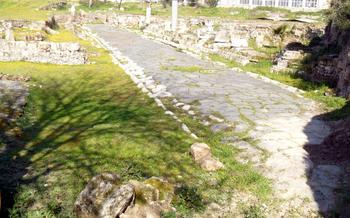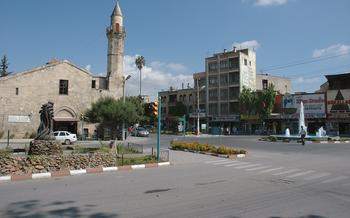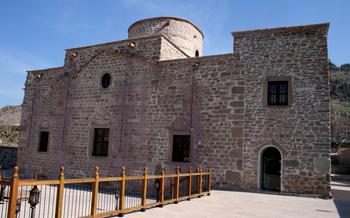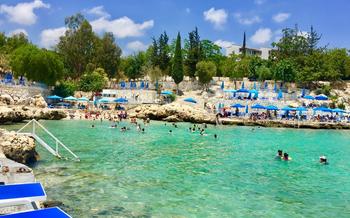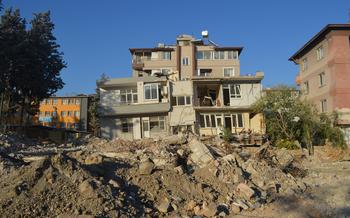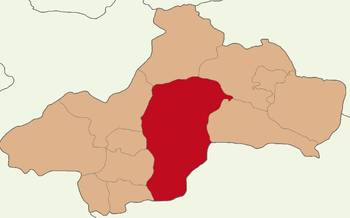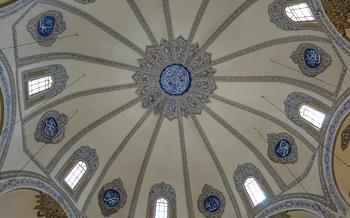
St. Paul Church Tokat
- The Antiquity of St. Paul Church Tokat
- The Architecture and Design of St. Paul Church Tokat
- The Role of St. Paul Church Tokat in Christianity
- Preservation and Restoration of St. Paul Church Tokat
- The Cultural and Historical Significance of St. Paul Church Tokat
- Visiting St. Paul Church Tokat
- Exploring the Surroundings of St. Paul Church Tokat
- St. Paul Church Tokat in Literature and Arts
- The Spiritual Experience at St. Paul Church Tokat
- Local Customs and Traditions Surrounding St. Paul Church Tokat
- Events and Activities at St. Paul Church Tokat
- The Archaeological Significance of St. Paul Church Tokat
- The Church's Role in Interfaith Dialogue and Harmony
- St. Paul Church Tokat as a Symbol of Resilience
- Insider Tip: Unveiling the Hidden Treasures of St. Paul Church Tokat
The Antiquity of St. Paul Church Tokat
The history of Christianity in Tokat dates back to the early centuries of the Common Era when the region was part of the Roman Empire. According to tradition, the apostle Paul visited Tokat during his missionary journeys and preached the gospel to the local population. This led to the establishment of a small Christian community in the city, which grew and thrived over the centuries.
In the 6th century, during the reign of Emperor Justinian I, a magnificent church was built in Tokat to honor Saint Paul. The church, which was dedicated to the apostle, became a center of worship for the Christian community in the region. It was constructed in the Byzantine architectural style, which was popular in the Eastern Roman Empire at the time. The church's unique features, such as its intricate mosaics and frescoes, reflected the artistic and cultural influences of the Byzantine period.
Over the centuries, the church has undergone several renovations and modifications. However, it has retained its original structure and architectural style, making it a valuable example of Byzantine architecture in the region.
The Architecture and Design of St. Paul Church Tokat
St. Paul Church Tokat stands as a testament to the architectural prowess of the Byzantine era, blending elements of Romanesque and Gothic styles. Its exterior facade captivates with intricate stone carvings, decorative arches, and a majestic bell tower that pierces the skyline. The church's domes, adorned with vibrant frescoes, add an ethereal touch to the structure, creating a harmonious balance between earthly and heavenly realms.
Stepping inside the church, visitors are greeted by a breathtaking interior that exudes an aura of sanctity. The nave, with its soaring columns and vaulted ceilings, leads the eye towards the altar, which is adorned with intricate carvings and a resplendent altarpiece. The aisles, lined with graceful arches, provide a sense of symmetry and elegance, while the transepts offer quiet spaces for contemplation and prayer.
Artistic elements abound within the church, adding to its visual splendor. Frescoes depicting biblical scenes and the lives of saints adorn the walls and ceilings, their vibrant colors retaining their brilliance despite the passage of time. Mosaic tiles, with their intricate designs and shimmering hues, create a captivating visual narrative that transports visitors back in time. Stained glass windows, with their delicate tracery and rich symbolism, filter the sunlight, casting a kaleidoscope of colors onto the interior, creating an atmosphere of ethereal beauty.
The Role of St. Paul Church Tokat in Christianity
St. Paul Church Tokat holds immense significance in the annals of Christianity, serving as a sacred sanctuary for early believers and playing a pivotal role in the dissemination of the faith throughout the region. Its association with Saint Paul, one of the most influential apostles of Jesus Christ, further elevates its status as a revered site of worship.
The church's origins are intertwined with the missionary work of Saint Paul, who is believed to have visited Tokat during his extensive travels to spread the Gospel. According to local tradition, Saint Paul preached at the site where the church now stands, leaving an enduring legacy that transformed the city into a significant center of Christianity.
Over the centuries, St. Paul Church Tokat became a beacon of faith for local believers, providing a communal space for prayer, worship, and spiritual growth. It served as a gathering place for Christians to celebrate religious festivals, commemorate important events, and deepen their connection with the divine.
Historical records indicate that the church played a crucial role in spreading Christianity beyond the confines of Tokat. Missionaries and evangelists associated with the church ventured into neighboring regions, carrying the message of Jesus Christ to new communities and establishing new Christian communities.
Throughout its existence, St. Paul Church Tokat witnessed numerous religious ceremonies, solemn masses, and sacred rituals. It became a venue for baptisms, marriages, and other important Christian sacraments, marking significant milestones in the lives of believers.
The enduring presence of St. Paul Church Tokat stands as a testament to the resilience and vitality of Christianity in the region. Despite facing challenges and periods of adversity, the church has remained a steadfast symbol of faith, inspiring generations of believers and serving as a source of strength and guidance for the Christian community in Tokat.
Preservation and Restoration of St. Paul Church Tokat
St. Paul's Church in Tokat, Turkey, has withstood the test of time, but it has also faced significant challenges due to its age, natural disasters, and periods of neglect. Recognizing the importance of preserving its heritage, conservation efforts and restoration projects have been undertaken to ensure the church's longevity.
Restoration Techniques and Challenges: The restoration process involved meticulous techniques and careful consideration of the church's unique features. Experts employed traditional methods and materials to maintain the church's authenticity. Challenges included addressing structural damage caused by earthquakes and restoring intricate details such as frescoes and mosaics.
Preservation Initiatives: Conservation efforts have focused on stabilizing the church's foundations, repairing damaged walls and arches, and maintaining the integrity of its architectural elements. Ongoing initiatives include regular maintenance, monitoring for potential risks, and promoting sustainable practices to ensure the church's preservation for future generations.
Collaboration and Expertise: The restoration projects have relied on the expertise of architects, historians, and conservators who specialize in preserving religious heritage. Local artisans and craftsmen have played a crucial role in replicating original techniques and materials, ensuring that the church's unique character is retained.
Preserving a Legacy: Through these dedicated preservation efforts, St. Paul's Church in Tokat stands as a testament to the enduring spirit of Christianity in the region. It continues to serve as a place of worship, a reminder of the past, and a symbol of hope for the future, thanks to the tireless work of those committed to its preservation.
The Cultural and Historical Significance of St. Paul Church Tokat
St. Paul Church Tokat holds immense cultural and historical significance, contributing to the rich tapestry of Tokat's identity. As a testament to the region's Christian heritage, the church stands as a symbol of faith, resilience, and cultural diversity. Its unique architectural style and artistic elements have earned it a place among the most notable landmarks in Tokat, attracting visitors from around the world.
The church's presence has profoundly influenced the city's cultural landscape, shaping its traditions, customs, and beliefs. It has fostered a spirit of interfaith dialogue and understanding, promoting tolerance and cooperation among different religious communities. Through its enduring legacy, St. Paul Church Tokat continues to inspire and uplift, serving as a reminder of the enduring power of faith and the enduring spirit of the human soul.
Visiting St. Paul Church Tokat
Practical Information for a Fulfilling Visit:
To experience the spiritual essence of St. Paul Church Tokat, plan your visit during its regular service hours, which can be found on the church's website or by contacting the local parish office. Guided tours are available for a deeper understanding of the church's history, architecture, and significance. These tours are led by knowledgeable guides who can share fascinating insights and anecdotes.
For a comfortable and hassle-free visit, consider the following tips:
-
Respectful Attire: When visiting a religious site, it's essential to dress modestly and respectfully. Avoid revealing or overly casual clothing.
-
Photography Etiquette: While photography is allowed inside the church, be mindful of others' spiritual experiences. Avoid using flash or taking photos during religious services or when people are praying.
-
Accessibility: The church strives to be welcoming and accessible to all visitors. If you have any accessibility concerns or require assistance, feel free to contact the church office in advance.
-
Spiritual Reflection: Take a moment to pause and reflect on the profound spiritual atmosphere of the church. Whether you're a religious pilgrim or simply seeking inner peace, allow yourself to be open to the tranquility and energy of this sacred place.
Exploring the Surroundings of St. Paul Church Tokat
St. Paul Church Tokat is nestled amidst a vibrant neighborhood with a rich history and cultural significance. The surrounding area offers a myriad of attractions for visitors to explore and delve deeper into the city's heritage.
Just a short walk from the church, visitors can discover the Tokat Museum, housing a collection of artifacts, historical documents, and ethnographic exhibits that provide insights into the region's past. The museum showcases the diverse cultural heritage of Tokat, from ancient civilizations to modern times.
Another nearby attraction is the Tokat Castle, an imposing structure that stands as a testament to the city's resilience. Perched atop a hill, the castle offers breathtaking panoramic views of the city and the surrounding countryside. Visitors can explore the castle's ramparts, towers, and dungeons, immersing themselves in its intriguing history and legends.
For those seeking a spiritual experience beyond St. Paul Church Tokat, the Great Mosque of Tokat is a must-visit. This magnificent mosque, with its elegant architecture and serene atmosphere, is a significant center of worship for the Muslim community. Visitors are welcome to explore the mosque's courtyard, prayer hall, and minarets, gaining a deeper understanding of Islamic culture and traditions.
The neighborhood surrounding St. Paul Church Tokat is also a culinary haven, offering a variety of traditional Turkish cuisine. Visitors can savor delicious kebabs, gözleme (stuffed flatbread), and other local specialties at the nearby restaurants and cafes.
For a more immersive experience, visitors can embark on a guided tour of the area, led by knowledgeable local guides who can share fascinating stories and anecdotes about Tokat's history, culture, and hidden gems.
St. Paul Church Tokat in Literature and Arts
St. Paul Church Tokat has served as a muse and inspiration for artists, writers, and historians throughout the centuries. Its unique architecture and historical significance have been captured in various forms of art and literature.
In the realm of literature, the church has been mentioned in historical accounts and travelogues, providing valuable insights into its past. Local legends and folklore often intertwine with the church's history, creating a tapestry of stories that have been passed down through generations.
The church's striking appearance has also been immortalized in paintings and sketches. Artists have captured its intricate details, from the domes and arches to the frescoes and stained glass windows, preserving its beauty for posterity.
Moreover, the church's spiritual essence has resonated with poets and writers, who have penned verses and prose that evoke its serene atmosphere and the sense of awe it inspires. These literary works serve as a testament to the church's enduring impact on the hearts and minds of those who encounter it.
The church's influence extends beyond traditional art forms. In recent years, it has become a popular subject for photography, with visitors capturing its grandeur and charm through their lenses. The church's unique features, such as the play of light and shadow on its stone facade, offer endless opportunities for creative expression.
St. Paul Church Tokat continues to inspire and captivate artists and visitors alike, serving as a source of inspiration and a reminder of the enduring power of faith, history, and beauty.
The Spiritual Experience at St. Paul Church Tokat
St. Paul Church in Tokat exudes a serene and hallowed atmosphere, inviting visitors to immerse themselves in prayer and reflection. Its tranquil surroundings and sacred spaces provide a conducive environment for spiritual introspection and connection with the divine.
Over the centuries, countless pilgrims and religious travelers have flocked to St. Paul Church, seeking solace, guidance, and a deeper understanding of their faith. The church's rich history and association with Saint Paul, a revered apostle who spread Christianity throughout the region, enhance its spiritual significance.
Visitors to the church often describe a profound sense of peace and tranquility as they step inside its ancient walls. The soft glow of candles illuminates the intricate frescoes and mosaics that adorn the interior, creating a mystical ambiance that encourages contemplation and spiritual growth.
Personal stories abound of individuals who have experienced a transformative spiritual connection at St. Paul Church. Some have reported feeling a tangible presence of the divine, while others have found clarity and direction in their lives through prayer and meditation within the church's sacred space.
For those seeking a deeper spiritual experience, St. Paul Church offers opportunities for spiritual retreats, workshops, and meditation sessions. These programs provide a structured environment for individuals to explore their faith, connect with like-minded seekers, and cultivate a closer relationship with the divine.
Whether you are a devout Christian seeking a pilgrimage site or simply an individual searching for a place of peace and spiritual renewal, St. Paul Church in Tokat offers a sanctuary for reflection, introspection, and a profound connection with the divine.
Local Customs and Traditions Surrounding St. Paul Church Tokat
St. Paul Church Tokat is deeply intertwined with the local customs and traditions of the region. One unique custom associated with the church is the annual feast day celebration in honor of Saint Paul, the church's patron saint. This festival, held on June 29th, draws pilgrims and visitors from far and wide. During the celebration, locals participate in a traditional procession carrying the icon of Saint Paul through the streets of Tokat, accompanied by prayers, hymns, and music. The festival culminates in a grand mass at the church, followed by communal feasts and gatherings.
Another significant tradition is the lighting of candles at the church. Devotees often light candles as a symbol of their prayers and petitions, seeking blessings and guidance from Saint Paul. The flickering candlelight creates a serene and spiritual atmosphere within the church, adding to its sacred ambiance. Additionally, locals believe in the healing power of the church's holy water. Many visitors collect the water from the church's fountain, believing it possesses healing properties for various ailments. These customs and traditions reflect the deep devotion and reverence that the local community holds for St. Paul Church Tokat, showcasing the church's enduring significance in the cultural and religious life of the region.
Events and Activities at St. Paul Church Tokat
St. Paul Church Tokat remains an active religious and community hub, hosting regular religious services, masses, and prayer meetings. These services provide opportunities for worshippers to come together, pray, and celebrate their faith. Visitors are welcome to attend these services, experiencing the vibrant spiritual atmosphere and observing the local religious traditions.
In addition to regular services, the church also organizes special events, concerts, and exhibitions within its premises. These events showcase the church's rich history, artistic heritage, and cultural significance. Visitors can enjoy concerts featuring religious music, attend exhibitions showcasing historical artifacts or contemporary Christian art, or participate in educational workshops related to the church's history and architecture.
St. Paul Church Tokat also offers opportunities for volunteering and community service. Visitors can get involved in various initiatives, such as helping with church maintenance, assisting with community events, or providing support to local charities. Volunteering at the church is a meaningful way to contribute to the community and connect with fellow believers.
Educational programs or workshops are occasionally offered at St. Paul Church Tokat, providing visitors and locals with opportunities to deepen their understanding of the church's history, theology, and significance. These programs may cover topics such as the life of Saint Paul, the development of Christian architecture, or the role of the church in the local community. Visitors can participate in these programs to gain insights into the church's rich heritage and its ongoing relevance in the modern world.
The Archaeological Significance of St. Paul Church Tokat
St. Paul Church Tokat holds immense archaeological significance as it offers valuable insights into early Christian architecture and history. Archaeological excavations conducted around the church site have unearthed numerous artifacts and relics that shed light on the church's origins and evolution. These discoveries include ancient pottery fragments, inscriptions, and architectural elements that provide clues about the church's construction and subsequent modifications.
The church's unique architectural style, combining Byzantine and local influences, has attracted the attention of scholars and archaeologists. Detailed studies of its structural features, such as the vaulted ceilings, intricate arches, and decorative elements, have contributed to our understanding of the development of early Christian architecture. Moreover, the church's well-preserved condition allows researchers to gain insights into the construction techniques and materials used during that period.
Among the significant archaeological finds at St. Paul Church Tokat are fragments of frescoes and mosaics that once adorned the church's interior. These artistic elements depict biblical scenes and figures, providing valuable information about the iconography and artistic traditions of the early Christian community. The discovery of these artifacts has helped scholars reconstruct the church's original appearance and the role of art in its religious practices.
Ongoing archaeological projects and research initiatives continue to explore the surroundings of St. Paul Church Tokat, aiming to uncover further evidence of its historical significance. These endeavors contribute to our understanding of the church's place within the broader context of early Christian settlements and the development of Christianity in the region.
The Church's Role in Interfaith Dialogue and Harmony
St. Paul Church Tokat has played a significant role in promoting interfaith dialogue and understanding within the community. The church has actively engaged in initiatives and events aimed at fostering religious tolerance and cooperation. Collaborations with other religious communities and organizations have been instrumental in creating a platform for open dialogue and mutual respect.
One notable initiative has been the organization of interfaith gatherings and seminars, where representatives from different faiths come together to share their beliefs and experiences. These events provide a space for constructive conversations, dispelling misconceptions and building bridges of understanding.
The church's commitment to interfaith dialogue extends beyond its own walls. It has actively participated in regional and national initiatives aimed at promoting harmony among different religious groups. By working together, St. Paul Church Tokat and other faith-based organizations strive to create a more inclusive and peaceful society where diversity is celebrated and respected.
The church's efforts have been recognized and appreciated by the wider community. It has received awards and accolades for its contributions to interfaith dialogue and its role in fostering religious understanding. St. Paul Church Tokat stands as a beacon of hope, demonstrating that through collaboration and mutual respect, people of different faiths can come together to build a better and more harmonious world.
St. Paul Church Tokat as a Symbol of Resilience
Despite the many challenges and adversities it has faced throughout history, St. Paul Church Tokat stands as a testament to the strength and resilience of the Christian faith. The church has survived earthquakes, fires, wars, and periods of persecution, yet it continues to serve as a place of worship and inspiration for the local Christian community.
One of the most remarkable examples of the church's resilience is its ability to adapt and endure through different periods of history. During the Byzantine era, the church was a prominent center of worship for early Christians. After the Ottoman conquest, the church was converted into a mosque but was eventually returned to the Christian community in the 19th century. Throughout these transitions, the church's architectural integrity remained largely intact, preserving its unique blend of Byzantine and Ottoman influences.
The stories of perseverance and hope associated with St. Paul Church Tokat are a testament to the enduring spirit of its congregation. During times of persecution, Christians in Tokat faced discrimination and hardship, but they continued to gather in secret to worship at the church. Their unwavering faith and dedication helped to preserve the church's legacy and ensure its survival for future generations.
Today, St. Paul Church Tokat stands as a symbol of resilience and hope for the Christian community in Tokat. Its ability to withstand the tests of time and adversity serves as a reminder of the strength of faith and the power of perseverance.
Insider Tip: Unveiling the Hidden Treasures of St. Paul Church Tokat
Beyond the main attractions, St. Paul Church Tokat holds several hidden gems and lesser-known aspects that offer unique experiences for visitors.
Explore the church's tranquil courtyard, often overlooked by visitors, to discover a serene oasis amidst the bustling city. Admire the intricate carvings and sculptures adorning the exterior walls, revealing the remarkable craftsmanship of bygone eras.
Venture into the church's crypt, where ancient artifacts and relics from the early Christian era are showcased. Immerse yourself in the rich history of the church and its role in shaping the region's religious landscape.
For a unique perspective, climb to the church's bell tower, accessible through a narrow spiral staircase. Enjoy breathtaking panoramic views of Tokat, with its historic landmarks and vibrant cityscape unfolding before your eyes.
To capture the essence of St. Paul Church Tokat, engage the services of a local guide. These knowledgeable individuals can provide in-depth insights into the church's history, architecture, and cultural significance, ensuring a truly immersive experience.
